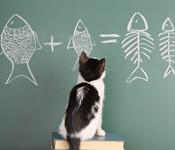The brain's recipe for jokes
 During a meal with friends, there is always someone who makes everyone laugh. Someone who has the gift of telling the funniest jokes, someone you listen to because you know you are going to have a good time. Maybe that person is you! But what do we know about the 'brain mechanisms of joking'? Which areas of the brain are required to tell the best jokes? Researchers have looked into the question.
During a meal with friends, there is always someone who makes everyone laugh. Someone who has the gift of telling the funniest jokes, someone you listen to because you know you are going to have a good time. Maybe that person is you! But what do we know about the 'brain mechanisms of joking'? Which areas of the brain are required to tell the best jokes? Researchers have looked into the question.
Humor is not the most studied topic in neuroscience. However, this human specificity can teach us a lot about how our brains work, and it's a fun topic to explore. Researchers from the University of Southern California have tried to determine the mechanisms behind jokes. The brains of fourteen comedians who specialize in improvisation were analyzed while thinking about jokes.
The experiment was carried out in the following way: while their brains were being analyzed by MRI, a series of drawings of interacting characters were shown to the comedians. In the first experiment, they had to invent situations by imagining a funny sentence pronounced by one of the characters. In the second experiment, they had to imagine a mundane sentence, without humor, which served as a control condition. After each test, they were asked to evaluate the humoristic quality of their own creations.
For a joke to be effective, the researchers discovered that the temporal lobe (located behind the temples) needed to be largely activated and significant activity was also required in the ventral striatum, the brain region which is linked to the reward system. This demonstrates that the development of comical ideas requires the activation of the temporal lobe, where opposing or distinct ideas can be linked in a relevant manner.
Furthermore, these temporal areas are rich in opiate receptors, notably the μ receptors which play an important part in the exhilarating effect of these substances. The scientists affirm that the sole activation of these areas produces an effect of pleasure which, in the context of humor, reaches the height of an intense positive feeling, which we call joy.
Moreover, it is interesting to note that the same areas are solicited both in the creation and in the appreciation of humor, but that the order of activation is reversed. In the case of appreciating humor, the temporal lobe is activated first, thus reflecting the joke comprehension process. This is followed by the reward, a pleasant sensation which can only occur if the joke has been previously understood. For the comedian, it is the opposite phenomenon which occurs; the expectation of the reward ensuing from the creation of a comical idea.
In this way, drawing on opposing and distinct ideas, comedians maximize their chances of making us laugh.
Source: Amir, O., & Biederman, I. (2014). The Neural Genesis of a Joke. Poster presented at the Society for Neuroscience (SfN), Washington, DC.







